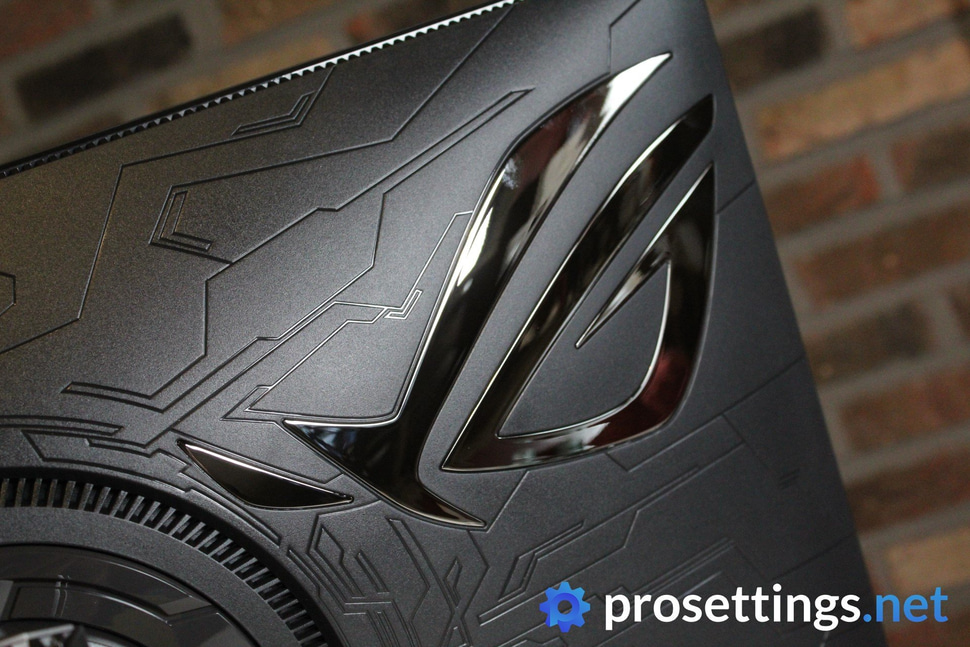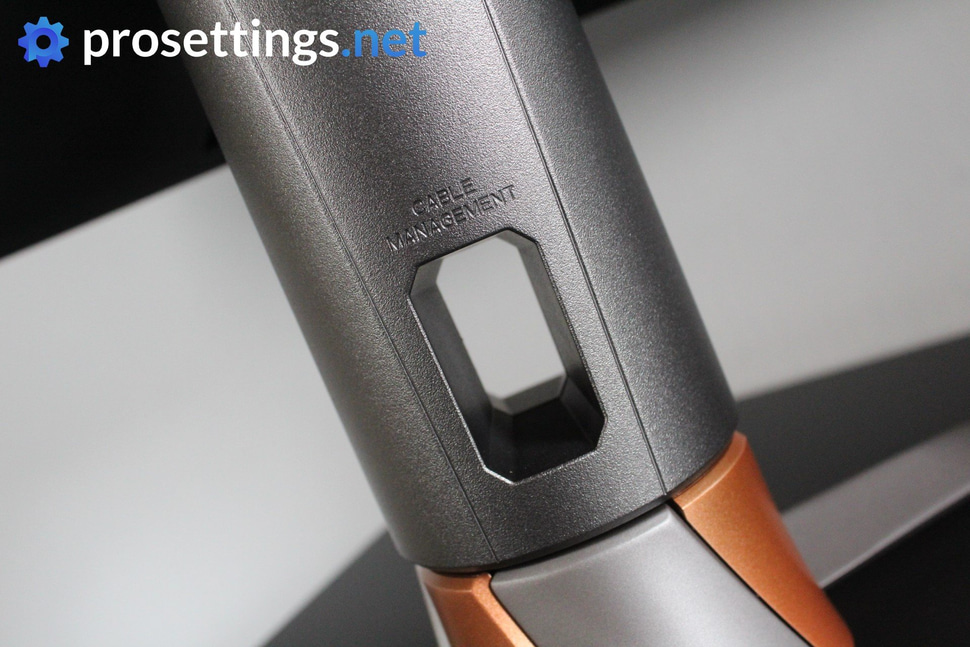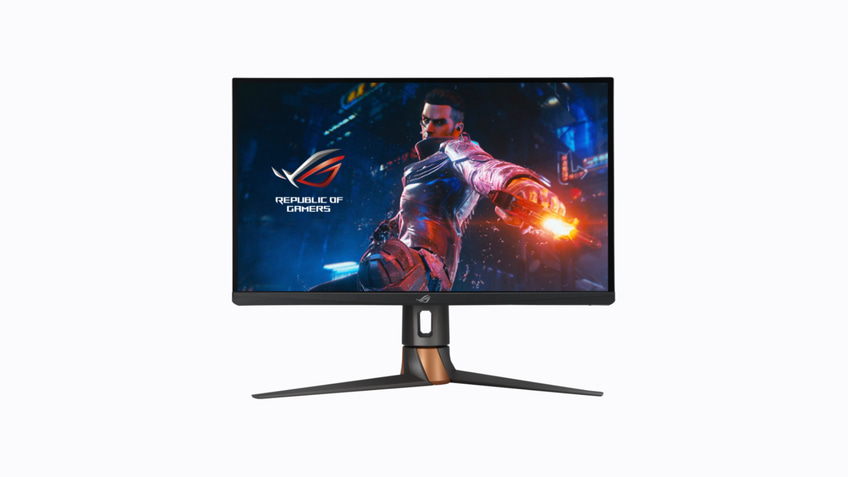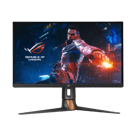Introduction
For the longest time, 1080p gaming monitors have been the standard in professional gaming. That’s because professional/competitive gamers prefer high framerates over visual fidelity since it’s quite simply better for performance reasons. Technology never stands still, however, and with the constant increase in computing power we might see a change towards 1440p becoming the standard in the (near) future. ASUS believes in this future, and this PG27AQN is meant to back up their belief. This is a 1440p 360Hz monitor with an Ultra-fast IPS display that’s meant to be the absolute top of the line when it comes to gaming displays.
Is this the next big revolution in competitive gaming? Is it the ultimate esports display? Read our full ASUS ROG Swift PG27AQN review to find out!
At A Glance
ASUS ROG Swift PG27AQN
Used by 5 players ()The ASUS PG27AQN is without a doubt the most complete and impressive all-round gaming monitor I’ve ever tested. It has such an impressive array of features and specs that it’s hard not to love it, and the Ultra-fast IPS panel does wonders to bring IPS monitors in line with TN monitors when it comes to response times and motion clarity.
Pros
- Great response times thanks to Ultrafast IPS Technology
- Great picture quality
- 1440p + 360Hz makes for a ultra high tier gaming display
- Basically has a 25″ 1080p monitor built into it in the form of the Esports 25″ mode
Cons
- No motion blur reduction technology present
- Stand has a rather large footprint
- Very expensive
Specs
| Size | 27″ |
|---|---|
| Resolution | 2560×1440 |
| Aspect Ratio | 16:9 |
| Refresh Rate | 360 |
| G-Sync | Yes |
| FreeSync | No |
| Panel Tech | IPS |
First Impressions
To start things off, I have to give credit where credit is due: the unboxing experience with this monitor is great. Everything’s neatly packed and you get absolutely all the cables and extras that you need in order to get started right inside the box. Of course these extras are to be expected when buying a monitor at this price point, but overall it was a pleasure to unpack this monitor. The box is also sturdy and rather easy to repack so it can be repurposed as a carrying box if you’re someone who is often gaming on the go.
One of the first things that you instantly notice when you unpack this monitor (if you’re a competitive gamer, that is) is the size. Most popular competitive gaming monitors are 24-25 inches, whereas this PG27AQN is 27 inches. That’s not a massive difference, but it is something that’s very noticeable if you’re coming from a smaller monitor. Aside from that, this is a typical ASUS gaming monitor on the outside.
Build and Operation
DESIGN
ASUS ROG monitors always have a certain look to them, and I’m not a huge fan. The whole monitor looks very ‘gamery’ and when it comes to monitors I am a fan of less shouty designs. Things like the large RGB logo at the back of the monitor can be turned off of course, but even when turned off it’s still very visible, and those ‘spaceship-like’ lines across the back of the monitor will obviously also stay where they are. Luckily the monitor looks a lot plainer from the front.
Looks are subjective so I won’t harp on about the design too much, but I do want to mention one thing and that’s the stand. This could have a smaller footprint if you ask me. I am aware that this stand is present on pretty much all ROG gaming monitors and that it’s sort of a ‘trademark look’ for them, but if you ask me this stand takes up a bit too much space. The monitor is VESA compatible so you can very easily put this monitor on an aftermarket stand or arm though.
On the back of the monitor you’ll find a joystick along with some buttons to navigate the OSD. This is extremely easy thanks to the multi-directional joystick, and I absolutely love it when companies make navigating the OSD of their monitors this effortless. Joysticks and the likes are becoming more and more common on gaming monitors these days, and that’s a great evolution if you ask me.
BUILD QUALITY & ADJUSTABILITY
Moving on from looks towards more important aspects then: the build quality and adjustability. The PG27AQN absolutely delivers on this front. The plastic being used is thick and sturdy, and the metal stand itself is heavy and extremely stable. Adjusting the monitor feels very smooth and pleasant, and it’s adjustable in all the right ways: height, tilt, swivel, pivot.
Getting the right viewing angle for you personally is absolutely no problem with this monitor, and once you’ve settled on a panel position it will stay there without any issues at all, even if you’re playing on a somewhat rocky desk and you have the tendency to slam into it after a failed clutch or two. I have absolutely no remarks on this front, and the PG27AQN feels every bit as premium as it should when you’re looking at the price.

Image Quality and Settings
PICTURE QUALITY
Historically speaking, one of the major disadvantages of high refresh rate panels has always been the picture quality. TN panels are extremely fast, yes, and they handle motion really well, but when it comes to the overall quality of the image they put out, they are left in the dust by other technologies. Those other technologies, in turn, had worse response times and weren’t as smooth as TN panels.
With Ultra-fast IPS panels, these compromises are a thing of the past. You’re getting the picture quality of a nice IPS panel (there’s more info on ASUS’ website; Ultra-fast IPS utilizes a bunch of different technologies in order to achieve these results) without having to make compromises when it comes to motion clarity and response times. The PG27AQN looks absolutely fantastic straight out of the box, and that’s not only because it looks sharper thanks to its higher resolution.
Color accuracy is great, and contrary to what I usually experience when unboxing new monitors, I didn’t feel as if I had to do any calibrating here. What’s also neat is that there’s a wide gamut color mode included in the settings, making colors more vibrant. That comes in handy for games such as CS:GO that look quite drab out of the box.
The PG27AQN is also one of the brightest monitors I’ve used. I don’t usually game in direct sunlight or anything like that so brightness is a secondary concern to me personally, but you’re getting plenty of light from this panel, and gaming in bright rooms should be no issue whatsoever.
All in all, the PG27AQN is the most impressive looking display I’ve tested so far. There’s of course the fact that it looks a lot sharper than a regular 1080p monitor, but it’s also nicely dialed-in straight out of the box and it displays colors beautifully. As with all IPS monitors, there is of course some IPS glow and the contrast ratio is also a little lacking but these things didn’t get in the way of my enjoyment.
SETTINGS
The PG27AQN has a ton of settings meant to make the life of any gamer (a lot) easier. There’s the wide color gamut mode that I mentioned previously, but it also comes with G-Sync and a bunch of gaming-centered features such as Dark Boost. This enhances the brightness of darker areas without overexposing the brighter sections of the (game) world, making it a lot easier to spot enemies who are situated in shadowy environments. There are also gaming-centered presets such as Racing, FPS, and so on, as well as the ‘usual stuff’ such as low blue light settings.
If you can think of it, the PG27AQN probably has it, but the most impressive feature (in my opinion at least) is the Esports dual-mode. This basically changes your monitor from a 27-inch 1440p display to a 25-inch 1332 or 1080p display. This is absolutely fantastic, as it means that you can use the larger, sharper screen for games where you can easily hit enough frames (or single player games where framerates don’t really matter) and then move to the regular 25-inch display when it’s time to tryhard in your game of choice. When you use the Esports mode, the monitor renders bezels in order to reduce the screen size, so it’s not as if you’re playing on some weird stretched resolution. Using this mode in 1080p does result in some blurring, so I recommend going for 1332p if you want to use the 25-inch mode.
One downside is that the PG27AQN doesn’t come with any form of motion blur reduction technology.
Ingame Performance
1440P VS 1080P
One of the most important questions when considering this monitor is probably going to be ‘does 1440p enhance your gameplay’ and the answer to that isn’t very clear. It’s not as if I went from being a chump to a headshot honcho when I switched to the PG27AQN, but using a higher resolution does of course make the game you’re playing look a lot sharper, and this can give you an advantage when engaging enemies at a distance or when peering through densely populated areas in the game world. So yes, using a higher resolution can make you more consistent and can make aiming easier in certain scenarios, but it’s not some kind of hack that’ll increase your headshot percentage by 20%.

It does really make a difference in how you experience a game, at least for me. The image is sharper and the screen is slightly bigger than a regular esports monitor, so you do feel a lot more engrossed when playing. Does that mean you’re going to be playing better? No, not for me. But it’s good to have the option.
Perhaps this is something that you get used to over time, but I’ve used this monitor for a month now and it still occasionally surprises me how good this monitor looks. It’s a really pleasing experience, and while I initially thought I would be using the 25″ Esports mode all the time due I found myself staying at 1440p for the majority of my testing.
How all of this impacts you personally will obviously depend on your personal experiences, but one thing is for sure: gaming at 1440p certainly doesn’t have any objective downsides (as long as your PC can handle it) so I could certainly see this becoming the standard competitive resolution in the future. PCs are getting more and more powerful with every generation, and with certain games we’re definitely getting to that point where playing at 1440p isn’t a self-imposed handicap when it comes to framerates.
Most competitive PC games are built to run on low tier hardware (even newer ones such as VALORANT and Overwatch 2) so I don’t think that the increase in graphical technologies is going to be impacting competitive gamers very much. It’s not as if CS2, for example, is going to have an RTX4080 as a minimum requirement, so if you consider the fact that competitive games are rather stale (by design) when it comes to the required system specs and that PCs are constantly getting more and more powerful, then you can conclude that the move to 1440p would be a logical evolution.
GAMING PERFORMANCE
A monitor can have all of the latest bells and whistles and dazzle you with its looks, but if the gaming performance isn’t up to par then it’s not worth a cent to a truly competitive gamer. ASUS promises to leave gameplay issues that have historically plagued IPS monitors (reduced motion clarity and response times) in the past, and they absolutely deliver on that promise. The PG27AQN isn’t the most responsive monitor out there (that honor goes to ZOWIE’s 360Hz gaming monitors) but it’s mightily impressive. For the best clarity, I would recommend going with the normal overdrive mode (the higher modes introduce ghosting) and using the wide color gamut mode.
Tracking fast-moving enemies, headshotting people camping in pit on Dust 2 in CS:GO (I sadly don’t have access to CS2), spotting enemies hiding in bushes in the Witcher 3, enjoying the sights of the town in GTA5 at max settings: this monitor performs perfectly in all situations, and that’s one of this product’s greatest strengths. You don’t need to sacrifice image quality for performance (or vice versa) with this monitor, and even if you’re playing a game that’s tough to run at competitive framerates you can just use the Esports mode and basically play on a regular top tier 25″ monitor. The PG27AQN is extremely impressive on all fronts.
Of course you do need a beefy PC in order to get the most out of this monitor. Reaching 360 frames per second is no easy feat, definitely if you’re gaming at 1440p, so this monitor really is aimed at people who want to futureproof their battlestation and/or people who have a top tier PC.
NVIDIA REFLEX
The PG27AQN is NVIDIA Reflex compatible. This means that you can measure your system latency with the build in Latency Analyzer. This isn’t something that’ll consistently enhance your gaming experience but it’s something that comes in handy if you want to test your setup and if you want to optimize your overall system latency for the best competitive performance.
Conclusion
The ASUS PG27AQN is without a doubt the most complete and impressive all-round gaming monitor I’ve ever tested. It has such an impressive array of features and specs that it’s hard not to love it, and the Ultra-fast IPS panel does wonders to bring IPS monitors in line with TN monitors when it comes to response times and motion clarity.
If you’re a die-hard competitive gamer and you don’t care about visuals or graphics then there are definitely options out there that are friendlier on your wallet and perform just as well (or even better, though you’d have to look at top tier 360Hz TN monitors for that) but as a type of ‘I want it all’ monitor, this is one of the best you can get right now.
Gaming at 1440p is a really pleasant experience, and due to the fact that the PG27AQN basically has a 25″ monitor built into it (in the form of the Esports 25″ mode) you don’t even have to make any sacrifices if you decide to go for this one. If you want to game at lower resolutions or screen sizes, just select that option in the easy to navigate OSD and you’re ready to go.
This is a 1440p 360Hz IPS monitor with a fantastic image quality straight out of the box and a gaming performance that puts it up there with the very best. It does come at a price though, both literally and figuratively. The monitor itself costs a pretty penny, and you will need a very beefy PC to run games at 1440p and enough frames to get the most out of a display like this. If you’re not all that focused on competitive gaming there are also cheaper 1440p IPS alternatives out there with worse motion clarity and response times (which wouldn’t matter so much if you’re not a competitive player) so for those reasons I would only recommend the PG27AQN to (competitive) gaming enthusiasts or people who want to future-proof their overall build. It is one heck of an impressive product though, and from my experience it’s the most impressive all-round gaming monitor I’ve ever tried.












There is now motion blur technology. It is NVidia’s ULMB 2 (Ultra Low Motion Blur)